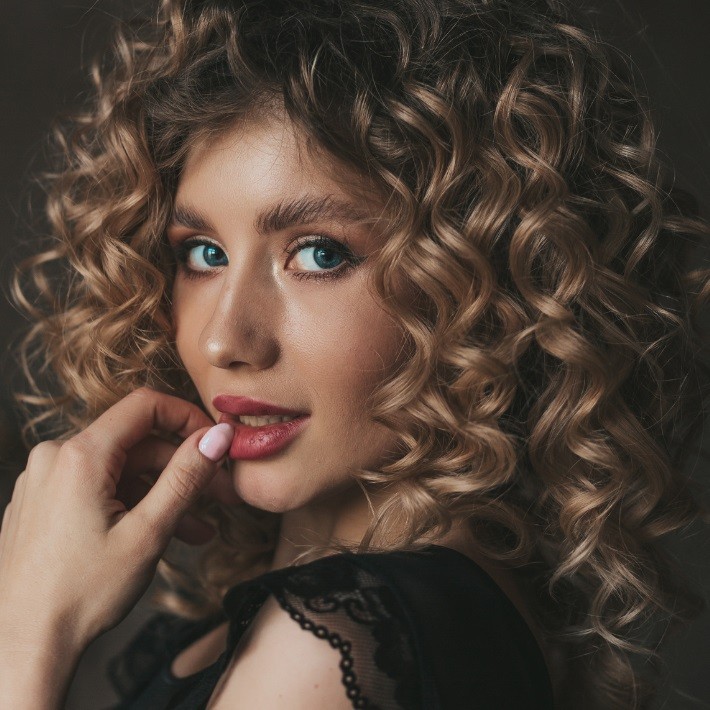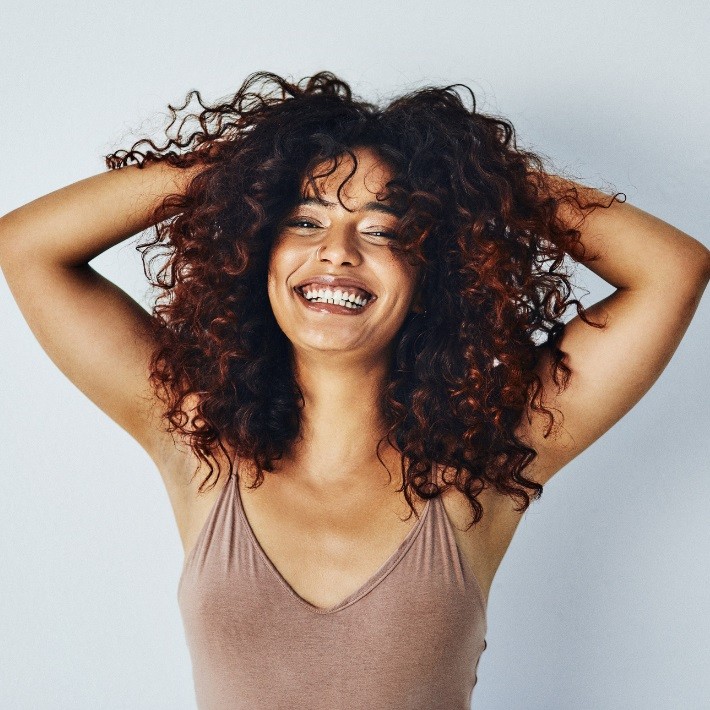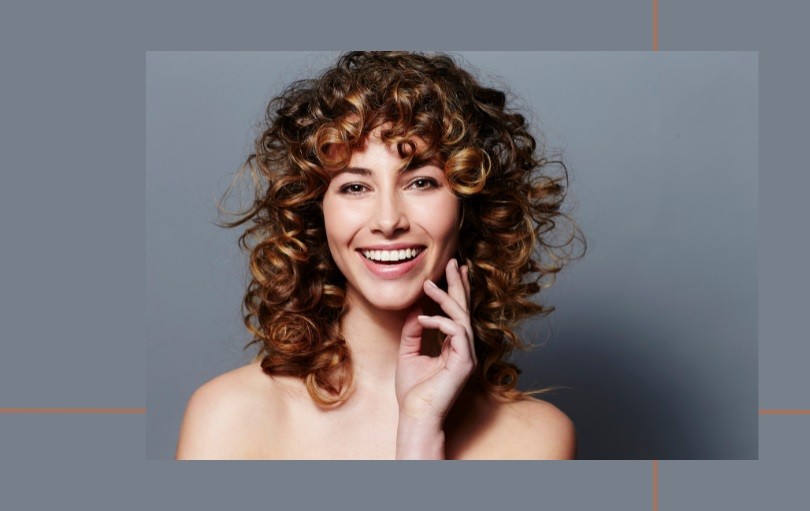Last Updated on March 28, 2025
Approximately 65% of people worldwide have naturally curly hair. Curly hair is caused by a genetic trait that determines the shape of the hair follicle.
The follicle’s shape, in turn, affects the angle at which the hair grows out of the scalp and the degree of curliness. While curly hair is often associated with certain ethnic groups, such as African Americans and people of Mediterranean descent, it occurs in people of all ethnicities.
In recent years, there has been a growing movement to embrace natural curls, with many individuals opting to wear their hair curly rather than straightening it with heat or chemicals. This trend has spurred the development of a wide range of hair care products specifically designed for curly hair, including shampoos, conditioners, and styling products.
What Is Curly Hair?

Defining Curly Hair
What exactly is curly hair? Curly hair refers to hair that’s formed into ringlets or coils throughout the hair shaft. Curly hair can vary in texture, ranging from wavy (loose curls) to coily (tight, springy, defined curls). Hair that’s curly to the point of forming tight coils is also referred to as “kinky hair”.
Related: Why Does My Hair Curl At The Ends?
Differentiating Curly Hair From Wavy Hair And Straight Hair
Curly hair is easily distinguishable from straight hair, but how do you differentiate curly hair from wavy hair? The key is in the pattern. Wavy hair has a looser, less defined pattern than curly hair, forming a wavy shape or s shape.
Curly hair, on the other hand, forms defined ringlets or coils. Additionally, curly hair tends to be thicker and more voluminous compared to straight hair.
To differentiate curly hair from wavy hair and straight hair:
- Look at the hair shaft’s pattern.
- Determine if the hair forms tight curls or looser waves.
- Examine the hair’s thickness and volume.
Curly hair is a unique characteristic that a large percentage of the world’s population shares. Defining curly hair and differentiating it from wavy and straight hair can help people understand their hair type better. Knowing your hair type is essential for proper hair care, so it’s important to know how to differentiate curly hair from other hair types.
Prevalence Of Curly Hair
Curly hair is a unique characteristic that some people possess, which makes them look more attractive and trendy. Many people love to flaunt their locks, and today we are discussing what percentage of people have curly hair and the factors that contribute to it.
Statistical Representation Of People With Curly Hair
Curly hair is not uncommon. In fact, it is estimated that approximately 65% of people in the world have curly hair to some extent. While this may seem like a high number, it is essential to note that not all curly hair is the same.
Therefore, a breakdown of curly hair types is necessary.
Break Down Of Curly Hair Types
There are three primary types of curly hair, which are categorized based on their texture and shape. These include:
- Type 2 (wavy hair): Hair that has s-shaped waves with loose curls.
- Type 3 (curly hair): Hair that has tighter, springy curls that form ringlets.
- Type 4 (coily hair): Extremely curly hair that is tightly kinked with a zig-zag shape.
It is noteworthy that each of these types has further subcategories, but this breakdown is sufficient to describe what percentage of people have curly hair.
Genetic Factors And Curly Hair
Hair type, including curly hair, is mostly determined by genetics. Specific genes that control hair texture and shape are inherited from both parents. Interestingly, researchers have identified six genes that contribute to the development of curly hair. Other factors such as ethnicity, lifestyle, hormonal changes, and hair care practices also affect hair curliness.
Curly hair is prevalent worldwide, and its type and texture depend on several factors. Approximately 65% of people globally have curly hair, with varying degrees of curliness. Genetics plays a significant role in determining hair texture and shape, but other factors also influence this characteristic.
Flaunt your curly hair, love it, and remember to take good care of it.
Related: Why Does My Hair Flick Out At The Ends?
Characteristics Of Curly Hair
Curly hair is a characteristic that many people can identify with. According to research, about 65% of the world’s population has curly hair. We will explore the characteristics of curly hair, such as physical features, curl patterns and lengths, and common hair-care challenges faced by people with curly hair.
Let’s delve into each of these factors.
Physical Features Of Curly Hair
Curly hair is easily identifiable by its coiled or wavy shape. Some of the features of curly hair include:
- Lack of shine due to the hair’s natural texture
- Tangles, knots and frizz
- Different textures throughout the scalp, which can lead to styling and hair care difficulties
- Porosity, making curly hair prone to dryness
- A difficult time maintaining length due to breakage
Curl Patterns And Lengths
Curly hair patterns vary from person to person, with different curl types ranging from loose waves to tightly coiled curls. Understanding the curl pattern is crucial for determining the appropriate hair care and styling practices. The most common curly hair patterns include:
- Type 1: Loose, barely-there waves
- Type 2: Defined waves or loose curls
- Type 3: Tighter curls that range from spiral to spring-like coils
- Type 4: Small, tightly coiled, and prone to shrinkage
Curly hair’s length is often misleading due to its tight-coiled nature, which can make it seem shorter than it genuinely is. The lengths of curly hair can vary from short to very long.
Common Hair-Care Challenges Of Curly Hair
Curly hair is a source of pride for many, but its care comes with challenges. Here are some common hair-care challenges people with curly hair face:
- Dryness, which leads to tangles and knots
- Breakage due to the hair’s fragility, making it prone to damage
- Difficulty combing or brushing
- Styles not lasting as long as straight hair
- Limited styling options. Many styles that work for straight hair require modifications for curly hair.
Understanding the characteristics of curly hair is crucial for effective hair care and styling. By keeping in mind the physical features, curl patterns and lengths, and common hair-care challenges, people with curly hair can maintain healthy and stylized hair.
Hair Structure: The Root Of Curly Hair

Have you ever wondered how hair gets its shape? Hair structure plays a significant role in determining whether your hair is straight, wavy, or curly. Curly hair, in particular, has a distinct structure that sets it apart from other hair types.
Here’s what you need to know.
Anatomy Of Hair Shaft
The hair shaft is the visible, outermost part of the hair that you can see and touch. It consists of three layers: the cuticle, cortex, and medulla. In curly hair, the cortex is elongated and flattened, creating bends and kinks in the hair.
The Role Of Keratin, Melanin, And Other Hair Components In Curly Hair
Keratin, a protein found in hair, skin, and nails, is responsible for hair’s strength and flexibility. In curly hair, the keratin fibers are twisted, causing the hair to curl. Melanin, the pigment that gives hair its color, also plays a role in curly hair.
People with darker hair tend to have curlier hair because their hair contains more melanin.
Other components of hair, such as proteins and amino acids, also contribute to curly hair. These components are responsible for the elasticity and curl pattern of the hair.
The Hair Growth Cycle And How It Affects Curly Hair
All hair goes through a growth cycle that consists of three phases: anagen, catagen, and telogen. The anagen phase is the active growth phase, and the hair can grow up to six inches in this phase. In curly hair, the anagen phase is shorter, which means that curly hair has a shorter growth cycle than straight hair.
The catagen phase is when the hair stops growing, and the follicle begins to shrink. This phase lasts for about two weeks. The telogen phase is the resting phase, and the hair falls out during this phase. In curly hair, the hair follicles are curved, making it harder for the hair to fall out.
This is why people with curly hair tend to shed less hair than those with straight hair.
Understanding the hair growth cycle can help you take better care of your curly hair. Proper hair care, such as using a gentle shampoo and conditioner, can help keep your hair healthy and prevent breakage. So, if you have curly hair, embrace your natural curls and take good care of them!
Genetics And Curly Hair: Exploring Hereditary Factors
Curly hair is a unique feature that many people possess. Have you ever wondered what percentage of people worldwide have curly hair? The answer may surprise you. According to research, approximately 65-85% of people have naturally curly hair. Genetics plays a significant role in determining our hair type and texture.
Let’s explore genetic factors relating to curly hair further in this blog post.
The Role Of Genetics In Determining Hair Type And Texture
Our hair type and texture are primarily determined by our genetics. Our heredity influences the number of hair follicles we have, the shape of our hair follicles, and the amounts of pigment that our hair follicles produce. Genetic makeup is responsible for our hair thickness, elasticity, and porosity.
This information concludes that every individual’s hair type is unique and varies from person to person.
Breakdown Of Hair Keratin Genes
Hair type and texture are also determined by the keratin genes that regulate hair follicle development. Keratin proteins are responsible for the texture, curliness, and hardness of hair. There are three types of hair keratin genes:
- Type 1 genes produce hard, straight hair.
- Type 2 genes produce wavy or curly hair.
- Type 3 genes produce curly or kinky hair.
The combination of these genes results in a wide range of hair types and textures.
Hair Follicle Development And Growth
Hair follicles grow in a cycle of stages, including a growth phase, a transition phase, and a resting phase. The length of each hair strand is determined during the growth phase, while the hair’s shape is determined during the transition phase.
The resting phase marks the end of the hair growth cycle, and the hair falls out, making way for new hair growth. The shape and texture of our hair depend on the follicle’s shape, which is established before birth.
An individual’s hair type and texture are primarily determined by genetics. Factors such as the number of hair follicles, their shapes, keratin genes, and the hair growth cycle result in a wide range of unique hair types and textures. It is fascinating to learn how our genes influence our physical features, including our hair.
Environmental Factors That Affect Curly Hair
Curly hair is a beautiful and unique feature that many people possess. But have you ever wondered what percentage of people have curly hair? According to research, approximately 65% of the human population has naturally curly or wavy hair. Various factors impact the shape and texture of curls.
In this blog post, we will explore the environmental factors that affect curly hair, including climate, humidity, heat, styling tools, and chemical treatments.
Climate And Humidity On Curly Hair
The climate you live in has a direct impact on the shape and texture of your curly hair. Here are some key points to consider:
- In humid climates, moisture in the air can cause curly hair to expand, resulting in frizz. On the other hand, in dry climates, curly hair can become brittle and prone to breakage.
- Extreme temperatures, such as excessive heat or cold, can also affect curly hair. Exposure to the sun’s UV rays can cause hair to dry out and lose its natural shine.
- If you live in an area with harsh weather conditions, such as snow, rain, or wind, it’s essential to protect your curls with appropriate hair care products.
The Impact Of Heat And Styling Tools On Curly Hair
Heat styling tools, such as flat irons, curling irons, and hair dryers, can alter the natural texture of curly hair. Here are some key points to consider:
- Excessive heat damages the hair’s protein structure, leading to split ends and breakage.
- Frequent use of heat styling tools can permanently alter the texture of curly hair, resulting in looser curls or even straight hair.
- If you must use heat styling tools, it’s crucial to use a heat protectant spray and limit the temperature and frequency of their usage.
Chemical Treatments And Their Effect On Curly Hair
Chemical treatments, such as hair dye or relaxers, can also alter the natural texture of curly hair. Here are some key points to consider:
- Chemical treatments break down the hair’s protein bonds, leading to weaker hair that’s prone to breakage.
- Relaxers can permanently straighten curly hair, while coloring can lead to a loss of natural shine and moisture.
- If you want to color your hair or use relaxers, it’s crucial to seek out a professional stylist and ensure they use high-quality products that won’t damage your hair.
Curly hair is a unique and beautiful feature that many people possess. Environmental factors, such as climate, humidity, heat, styling tools, and chemical treatments, can all impact its shape and texture. By following the tips outlined in this blog post, you can keep your curls healthy and looking their best.
Related: How To Use Rosemary Water For Hair?
Curly Hair Care: Step-By-Step Guide

Curly hair requires extra care and attention compared to straight hair. In order to maintain your curls, you need to figure out the best cleansing and hydration methods, conditioner application and rinsing, and styling products and techniques.
Cleansing And Hydration
- Use a gentle shampoo to cleanse your hair instead of a harsh one, which can strip natural oils from your hair and make it dry.
- Don’t shampoo your hair every day; instead, do it once or twice a week.
- Apply a hydrating conditioner after shampooing to help soften and moisturize your hair.
- Do not use hot water while washing, just use lukewarm water to avoid removing the natural oils from your hair.
- Make sure to rinse your hair thoroughly to remove all the shampoo and conditioner.
Conditioner Application And Rinsing
- After shampooing, apply a small amount of conditioner to your hair from mid-length to the ends.
- Use your fingers or a brush and run it through your hair gently.
- Leave the conditioner on your hair for 5-10 minutes before rinsing it.
- While rinsing, use your fingers to massage your scalp and help remove any remaining conditioner.
Recommended Curly Hair Styling Products And Techniques
- Use a wide-tooth comb to detangle your hair gently after shampooing.
- Use a leave-in conditioner to keep your curls perfectly defined and frizz-free.
- Apply a small amount of curl-enhancing gel or cream to your hair before styling to define your curls.
- For best results, apply hair products and dry your hair with a diffuser attachment.
- Regularly deep condition your hair to keep it healthy and hydrated.
Remember, every curly head is unique, and it may take some time to find the best routine for your hair. Practice patience and consistency, and you will soon enjoy defined, bouncy curls that will turn heads wherever you go.
Styling Curly Hair: Dos And Don’ts
Best Practices For Styling Curly Hair
Here are some best practices to follow while styling curly hair:
- Use a wide-tooth comb or detangler brush to avoid damaging the curls.
- Consider using a leave-in conditioner to nourish your curls and make them more manageable.
- Avoid using heat-styling tools, such as a flat iron, as they can damage the hair and cause irreparable harm.
- Opt for a diffuser to dry your hair, instead of using a hairdryer, as it helps maintain the hair’s natural texture.
- Use styling products that are curly hair-friendly, such as creams, mousses, and gels.
Common Mistakes To Avoid When Handling Curly Hair
Styling curly hair can be challenging if you’re not familiar with its unique characteristics. Here are some mistakes to avoid:
- Brushing curly hair: Curly hair should never be brushed, as it can cause breakage and frizz.
- Overwashing curly hair: Overwashing can strip natural oils from the hair, leading to dryness and damage.
- Using the wrong hair products: Using hair products that are too heavy can weigh down the curls, while lightweight products may not provide enough hold.
- Not protecting curls at night: Sleeping on cotton pillowcases can absorb moisture from curly hair, leading to frizz and dryness.
Creating The Perfect Hair Care Routine For Curly Hair
Curly hair requires a specialized hair care routine to keep it looking its best. Here are some tips:
- Shampoo twice a week and condition daily to moisturize the hair.
- Use a hair mask once a week to deep condition and nourish the hair.
- Apply a styling product while the hair is still damp to define your curls and control frizz.
- Protect your curls overnight by sleeping on a silk or satin pillowcase.
- Trim your hair regularly to maintain healthy ends.
Overall, styling curly hair can be challenging but following these best practices and avoiding common mistakes can make the process easier. With a perfect hair care routine, your curls can look their best every day.
Frequently Asked Questions
What Causes Curly Hair?
Curly hair is caused by genetics and the shape of the hair follicle.
How Common Is Curly Hair?
Around 65% of people have curly or wavy hair.
Can Hair Become Curly Over Time?
No, hair cannot become curly over time, but it can change texture due to aging or chemical treatments.
Is Curly Hair More Prone To Damage?
Curly hair can be more prone to damage and breakage due to its unique structure and texture.
How Can I Care For Curly Hair?
Proper hydration, gentle detangling, and regular trims can help maintain healthy and defined curls. Avoid heat styling and harsh chemicals.
Conclusion
As we conclude the details guide on the percentage of people with curly hair, we can appreciate the beauty and diversity within our world. It’s fascinating to learn about the different types of textures and patterns that hair can take on, including the traits that are passed down through genetics.
Through research and statistics, we’ve discovered that roughly 65% of people have some degree of curl in their hair, with the remaining individuals being either straight or wavy. Although curls can be a challenge to maintain and style, they are also a cherished feature amongst many cultures and communities.
So whether you have curly hair or not, we hope this guide has provided valuable insights into the uniqueness of our individual traits and the wonders of human genetics.

